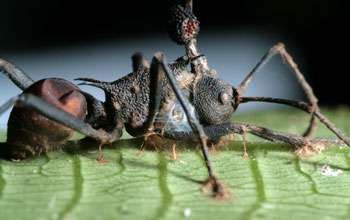Interactions
Ophiocordyceps unilateralis
is classified as a parasitic organism, so interaction with a host organism
is essential to the organism’s survival. The fungus infects Camponotus ants,
but which species is infected depends upon the subspecies of O. unilateralis
(Hughes 2010). The subspecies are very host specific, and if they are in the
presence of any other type of ant they will not be able to infect it (Hughes
2010).
O. unilateralis uses the ants for two purposes. The first
purpose is as a transportation unit that will move the fungus to an
environment suitable for reproduction(Pontoppidon et al. 2009). O. unilateralis does this by
hijacking the nervous system of the infected ant and essentially taking
control of its motor functions. Once the ant is in place, having bitten down
the second purpose becomes clear (Pontoppidon et al 2009).
as a transportation unit that will move the fungus to an
environment suitable for reproduction(Pontoppidon et al. 2009). O. unilateralis does this by
hijacking the nervous system of the infected ant and essentially taking
control of its motor functions. Once the ant is in place, having bitten down
the second purpose becomes clear (Pontoppidon et al 2009).
The next phase for the zombie ant fungus is to kill the ant and use it as a
nutrient source as it grows out of the ants head (Hughes 2010). It continues to grow in
its ideal environment and once the fruiting bodies are produced they are
released onto the forest floor (Hughes 2010).
Interestingly enough, this parasite can become infected by
another parasitic fungus. This parasitic fungus is smeared all over the ants
for the purpose of protection against O. unilateralis (Kennedy
2012). The hyperparasite is
extremely successful and when employed against the zombie ant fungus it
allows for only about 6.5 percent of the zombie ants spores to be viable for
reproduction (Kennedy 2012). The ants tend to cover themselves in this
parasite to protect themselves from protection (Kennedy 2012).

A relative to the zombie ant fungus,
O. sinensis, infects the larvae of ghost moths, been
subject to research in the medical field (Panda 2011). It has already become
a traditional medicine in China, and research continues on the possible
medicinal uses of the fungus (Panda 2011). The potential for medicinal uses
of Cordyceps fungi is still a relatively new field, but progress is being
made in a manner that industrial level production may be economically sound
in the near future. O. unilateralis, on the other hand, has no ill effects
on humans, nor does it provide any benefits for them. It has only been
documented to interact with the ants it infects (Hughes 2010). There have been no benefits
or harm done to humans, but it is an interesting study in chemical signaling
that affects the nervous system (Panda 2011). Other notable fungi that are involved in
the medicinal field include
Claviceps purprea,
Cordyceps subsessilis,
Pleurotus Ostreatus,
Ganoderma lucidum,
Lycoperdon pyriforme,
Trametes
versicolor,
Psilocybe cubensis,
Auricularia auriculara, and
Piptoporus betulines.
Fungi are amazing and
diverse organisms. To learn more about fungi from one of UW-L's own
professors, click
here!